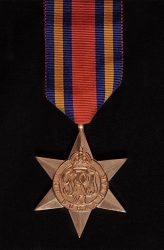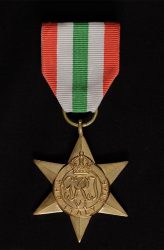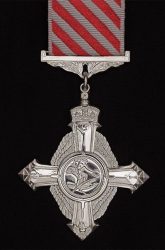The Medals They Won in WW2
Servicemen and women in WW2 could earn Campaign Stars for operating in various theatres of war, and individual Gallantry Medals or Bravery Awards.
The Campaign Stars
Nine stars were issued for the various campaigns of World War 2. The colours of the ribbons have symbolic significance and are believed to have been designed personally by King George VI.
1939 to 1945 Star
 This star was awarded to all personnel who completed operational service overseas between 3rd September 1939 and 8th May 1945 (2nd September in the Far East). The colours on the ribbon represent the three services, Army, Air Force and Navy. No more than 5 stars could be awarded to one person. Those who served in more campaigns would receive a clasp to be attached to the ribbon of one of the stars.
This star was awarded to all personnel who completed operational service overseas between 3rd September 1939 and 8th May 1945 (2nd September in the Far East). The colours on the ribbon represent the three services, Army, Air Force and Navy. No more than 5 stars could be awarded to one person. Those who served in more campaigns would receive a clasp to be attached to the ribbon of one of the stars.
Air Crew Europe Star
 This star was earned almost exclusively by personnel for operational flying from UK bases over Europe between 3rd September 1939 and 5th June 1944. Sixty days of operational flying was required. The colours of the ribbon represent the sky, night flying and enemy searchlights, to symbolise the continuous service of the Air Force by night and day.
This star was earned almost exclusively by personnel for operational flying from UK bases over Europe between 3rd September 1939 and 5th June 1944. Sixty days of operational flying was required. The colours of the ribbon represent the sky, night flying and enemy searchlights, to symbolise the continuous service of the Air Force by night and day.
Burma Star
 This star was awarded for operational service in Burma between 11th December 1941 and 2nd September 1945. Those serving in Bengal and Assam in India and in China, Hong Kong, Malaya or Sumatra between other specified dates could also qualify. The colours of the ribbon represent the sun, and British and Commonwealth forces.
This star was awarded for operational service in Burma between 11th December 1941 and 2nd September 1945. Those serving in Bengal and Assam in India and in China, Hong Kong, Malaya or Sumatra between other specified dates could also qualify. The colours of the ribbon represent the sun, and British and Commonwealth forces.
France and Germany Star
Defence Medal
 The Defence Medal was awarded to personnel in non-operational roles, such as working in headquarters, on training bases and airfields, or as members of the Home Guard. The medal was also awarded for non-operational service overseas, for example in India or South Africa. The colours of the ribbon symbolise enemy attacks on Britain’s ‘green and pleasant land’ and the black- out.
The Defence Medal was awarded to personnel in non-operational roles, such as working in headquarters, on training bases and airfields, or as members of the Home Guard. The medal was also awarded for non-operational service overseas, for example in India or South Africa. The colours of the ribbon symbolise enemy attacks on Britain’s ‘green and pleasant land’ and the black- out.
The War Medal 1939 - 1945
 The War Medal 1939–1945 was a British decoration awarded to all full time personnel of the Armed Forces wherever they had served during the war. Operational and non-operational service counted, provided personnel had completed 28 days service between 3rd September 1939 and the 2nd September 1945. In the Merchant Navy there was the requirement that 28 days should be served at sea.
The War Medal 1939–1945 was a British decoration awarded to all full time personnel of the Armed Forces wherever they had served during the war. Operational and non-operational service counted, provided personnel had completed 28 days service between 3rd September 1939 and the 2nd September 1945. In the Merchant Navy there was the requirement that 28 days should be served at sea.
Gallantry Medals
Victoria Cross (VC)
 The Victoria Cross is the premier Operational Gallantry award given for ‘most conspicuous bravery, or some daring or pre-eminent act of valour or self sacrifice, or extreme devotion to duty in the presence of the enemy’. It may be awarded to all ranks of the services and civilians and can be awarded posthumously.
The Victoria Cross is the premier Operational Gallantry award given for ‘most conspicuous bravery, or some daring or pre-eminent act of valour or self sacrifice, or extreme devotion to duty in the presence of the enemy’. It may be awarded to all ranks of the services and civilians and can be awarded posthumously.
Distinguished Service Order (DSO)
 The Distinguished Service Order is an operational gallantry award given for highly successful command and leadership during active operations. Personnel who perform a further act of such leadership which would have merited a second award of the would be issued with a gold bar. It may be awarded to all ranks of the services.
The Distinguished Service Order is an operational gallantry award given for highly successful command and leadership during active operations. Personnel who perform a further act of such leadership which would have merited a second award of the would be issued with a gold bar. It may be awarded to all ranks of the services.
Distinguished Service Cross (DSC)
Distinguished Flying Cross (DFC)
 The Distinguished Flying Cross is an operational gallantry award given to all ranks of the services in recognition of exemplary gallantry during active operations against the enemy in the air. Personnel who would have merited a second award of the would be issued with a silver bar ornamented by an eagle.
The Distinguished Flying Cross is an operational gallantry award given to all ranks of the services in recognition of exemplary gallantry during active operations against the enemy in the air. Personnel who would have merited a second award of the would be issued with a silver bar ornamented by an eagle.
There are impressive displays of medals in the Warwickshire Yeomanry Museum in the Court House, and the Fusilier Museum in St. John's House.












